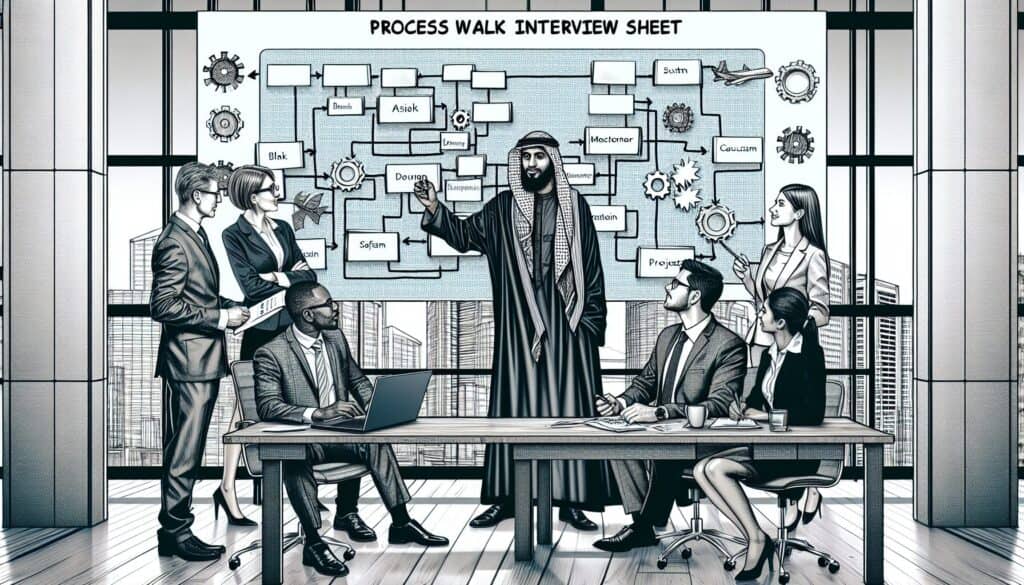Systematisches Sammeln von Informationen und Beobachtungen über einen Prozess direkt von den Beteiligten, indem man die Prozessschritte durchläuft.
- Methodologien: Kunden & Marketing, Ideenfindung, Produktdesign
Prozess Walk Interviewbogen

Prozess Walk Interviewbogen
- Kontinuierliche Verbesserung, Gemba, Schlanke Fertigung, Prozessverbesserung, Prozessabbildung, Prozess-Optimierung, Qualitätskontrolle, Qualitätsmanagement, Wertstrom-Mapping
Zielsetzung:
Wie es verwendet wird:
- Ein strukturiertes Formular oder eine Checkliste, die während einer Gemba Spaziergang (d.h. dorthin gehen, wo die Arbeit erledigt wird), um Fragen zu stellen, Antworten und Beobachtungen aufzuzeichnen und potenzielle Probleme oder Verbesserungsmöglichkeiten in Bezug auf Prozessschritte, Inputs, Outputs und Kontrollen zu ermitteln.
Vorteile
- Ermöglicht ein Verständnis des tatsächlichen Prozesses aus erster Hand; erleichtert die Zusammenarbeit mit den Mitarbeitern an der Front; hilft bei der Ermittlung versteckter Ineffizienzen und Probleme; sammelt qualitative Daten, die die quantitative Analyse ergänzen.
Nachteile
- Kann zeitaufwändig sein; die gesammelten Informationen können subjektiv oder anekdotisch sein, wenn sie nicht gut strukturiert sind; erfordert gute Interview- und Beobachtungsfähigkeiten; Potenzial für Voreingenommenheit der Beobachter.
Kategorien:
- Personalwesen, Lean Sigma, Herstellung, Problemlösung, Qualität
Am besten geeignet für:
- Erlangung eines tiefen Einblicks in den aktuellen Zustand eines Prozesses und Ermittlung von Verbesserungsmöglichkeiten durch direkte Beobachtung und Interaktion mit den Ausführenden der Arbeit.
Die Methode des Process Walk Interview Sheet ist besonders effektiv in Branchen wie der Fertigung, dem Gesundheitswesen und der Softwareentwicklung, wo komplexe Arbeitsabläufe ein gründliches Verständnis der täglichen Abläufe erfordern. Dieser Ansatz wird in der Regel im Rahmen von Verbesserungsinitiativen oder Qualitätsmanagementprojekten eingesetzt und ermöglicht es den Teams, Echtzeitinformationen direkt aus der Arbeitsumgebung zu erfassen. Er wird häufig von Prozessverbesserungsteams, Qualitätssicherungspersonal oder Projektmanagern initiiert, die sich mit den Mitarbeitern an der Frontlinie - also denjenigen, die mit den Prozessen bestens vertraut sind - auseinandersetzen und so die Zusammenarbeit und Transparenz fördern. Im Gesundheitswesen kann diese Methode beispielsweise Ineffizienzen im Patientenfluss oder in der Medikamentenverabreichung aufdecken, indem sie es Beobachtern ermöglicht, den Prozess in Aktion zu sehen und die Herausforderungen zu verstehen, mit denen das Personal im Gesundheitswesen konfrontiert ist. In der Fertigung können Engpässe in Produktionslinien aufgedeckt werden, was zu einer verbesserten betrieblichen Effizienz führt. Der Bogen regt nicht nur zu einer systematischen Untersuchung der Inputs und Outputs an, sondern ermutigt die Teilnehmer auch dazu, Bedenken und Vorschläge zu äußern, die die gesammelten qualitativen Daten bereichern. Diese Daten ergänzen traditionelle Messgrößen wie Zykluszeiten und Fehlerquoten und können in Phasen wie Lean Six Sigma-Projekten, die auf die Reduzierung von Verschwendung und die Verbesserung der Kundenzufriedenheit abzielen, hilfreich sein. Die Teilnehmer des Process Walk Interview Sheets werden ermutigt, Fragen zu formulieren, die sich auf verschiedene Aspekte beziehen, wie z. B. Sicherheitsvorschriften oder die Einhaltung von Verfahren, um eine umfassende Bewertung jedes Prozessschritts zu gewährleisten.
Die wichtigsten Schritte dieser Methodik
- Besuchen Sie den Arbeitsort und beobachten Sie den Prozess in Echtzeit.
- Setzen Sie sich mit den Mitarbeitern auseinander, um ihre Aufgaben und Herausforderungen zu verstehen.
- Stellen Sie offene Fragen, um bestimmte Prozessschritte zu klären.
- Dokumentieren Sie Beobachtungen und Interaktionen direkt auf dem Interviewbogen.
- Ermitteln Sie während der Begehung Abweichungen von den Standardverfahren.
- Achten Sie auf Anzeichen von Verschwendung oder Verzögerungen im Arbeitsablauf.
- Besprechen Sie mit den Teammitgliedern die Inputs und Outputs der einzelnen Schritte.
- Erkundigen Sie sich nach den bestehenden Kontrollen und den zur Leistungsbeurteilung verwendeten Messgrößen.
- Notieren Sie alle zusätzlichen Kommentare oder Erkenntnisse der Mitarbeiter.
- Schließen Sie den Rundgang mit einer Diskussion über mögliche Verbesserungsbereiche ab.
Profi-Tipps
- Verwenden Sie während des Gesprächs visuelle Hilfsmittel wie Prozessablaufdiagramme, um klare Diskussionen und die sofortige Identifizierung von Engpässen zu erleichtern.
- Benutzen Sie die "5 Warums"Technik, um bestimmte ermittelte Probleme zu vertiefen; dadurch werden Ursachen aufgedeckt, die auf den ersten Blick vielleicht nicht erkennbar sind.
- Aktualisieren Sie Ihren Process Walk Interview Sheet regelmäßig auf der Grundlage früherer Erfahrungen; beziehen Sie die gewonnenen Erkenntnisse ein und passen Sie die Fragen an, um sich auf neu erkannte Herausforderungen zu konzentrieren.
Verschiedene Methoden lesen und vergleichen, Wir empfehlen die
> Umfassendes Methoden-Repository <
zusammen mit den über 400 anderen Methoden.
Ihre Kommentare zu dieser Methodik oder zusätzliche Informationen sind willkommen auf der Kommentarbereich unten ↓ , sowie alle ingenieursbezogenen Ideen oder Links.
Historischer Kontext
1949
1950
1950
1960
1960
1960
1960
1940
1950
1950
1958
1960
1960
1960
1960
(wenn das Datum nicht bekannt oder nicht relevant ist, z. B. "Strömungsmechanik", wird eine gerundete Schätzung des bemerkenswerten Erscheinens angegeben)















Verwandte Artikel
Fragebögen zu muskuloskelettalen Beschwerden
Multivariate Tests (MVT)
Mehrfache Regressionsanalyse
Motion-Capture-Systeme
MoSCoW-Methode
Moods Median-Test